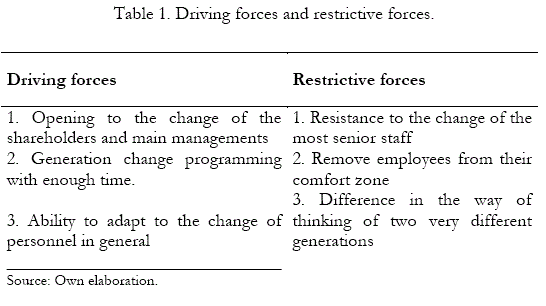Services on Demand
Journal
Article
Indicators
-
 Cited by SciELO
Cited by SciELO -
 Access statistics
Access statistics
Related links
-
 Similars in
SciELO
Similars in
SciELO
Share
Oikos Polis
Print version ISSN 2521-960XOn-line version ISSN 2415-2250
Oikos Polis vol.4 no.2 Santa Cruz de la Sierra Dec. 2019
ARTÍCULOS
Análisis de la percepción de la pertenencia y
el compromiso en la transición generacional.
Ensayo empírico de un consorcio Mexicano de empresas
dedicadas al comercio exterior
Analysis of the perception of belonging and the commitment
to the generational transition. Empirical essay of
a Mexican consortium of companies dedicated to foreign trade
José G. Vargas Hernándezπ, Laura Adame-Rodríguez£,
Karla Yvohone Delon Bacrep
π Research professor. Department of Administration, University Center for economic and
Managerial Sciences, University of Guadalajara.
Correo electrónico: josevargas@cucea.udg.mx, jgvh0811@yahoo.com, jvargas2006@gmail.com
£ Research professor. Division of Engineering in Business Management, TecNM/ Higher
Technological Institute of Pátzcuaro Michoacán, México.
Correo electrónico: ladame@itspa.edu.mx, laura_adame_r@hotmail.com
p Doctorado en Ciencias Administrativas Universidad Cristóbal Colón. Veracruz, México
Correo electrónico: karladb_76@yahoo.com.mx
Recepción: 05/05/2019 Aceptación: 08/10/2019
Resumen
La sucesión generacional es un tema que cobra vital importancia en las empresas familiares, ya que del éxito del proceso depende la permanencia de la empresa. Todos los pasos a seguir, así como la literatura del tema, son estudiados en el caso presentado, mismo que se acota a un Consorcio de empresas dedicadas al comercio exterior, cuyo corporativo se encuentra en la ciudad de Veracruz, con 30 años en el mercado y que se encuentra en el proceso de transición de la Presidencia del Consejo del padre a su hijo. El análisis incluye las diferencias generacionales existentes en la forma de pensar y por ende en la forma de dirigir a varias empresas del cual dependen más de 600 empleados y busca identificar si existen algunas variables que aseguren el éxito de un proceso de sucesión generacional.
Palabras clave. Éxito empresarial, Sucesión generacional, Negocio familiar, Habilidades de gestión.
Abstract
Generational succession is an issue that is of vital importance in family businesses, since the permanence of the company depends on the success of the process. All the steps to follow, as well as the literature on the subject, are studied in the case presented, which is limited to a Consortium of companies dedicated to foreign trade, whose corporate is located in the city of Veracruz, with 30 years in the market and that is in the process of transition from the Council Presidency of the father to his son. The analysis includes the existing generational differences in the way of thinking and therefore in the way of managing several companies on which more than 600 employees depend and seeks to identify if there are some variables that ensure the success of a generational succession process.
Keywords. Business success, Generational succession, Family Business, Management Skills.
CLASIFICACIÓN JEL: L22,L25.
1. INTRODUCCIÓN
Family businesses are very important in the Mexican country because of the income they earn and the jobs they generate. Derived from the foregoing, it is fundamental to carry out the succession of the leader of said companies in a correct manner, since the continuity of the same depends on that. More importantly, when you are the leader of a group of companies. The process of succession in the leader of the companies must be studied and prepared several years in advance. The preparation includes since the successor has the knowledge and experience required, until the leader who is going to delegate their duties and position, is prepared to really leave in other hands what for many years came with good results.
Another important part of the succession process that must be studied is the fusion of two generations, since, if not done correctly, it can generate important conflicts between the people involved. The ideal is to include as part of the processes, procedures, policies and values of the company the best, the experience of the first generation and innovation and new theories of the second.
This study focuses on a consortium of Mexican companies engaged in foreign trade with more than 30 years in the middle. The main objective is to describe the perception that shareholders, senior managers and employees in general have about their sense of belonging and commitment at a time of generational change in senior management in a Mexican Consortium of Companies Dedicated to Foreign Trade.
The specific objectives of this study are:
A. Identify the perception of the staff in relation to the managerial positions and the doubts that may be had when leaving the management of the Group in the hands of younger generations.
B. Describe the perception of executives and employees in middle management around an improvement in both the productivity of the company and the safety of processes at a time of generational change in senior management.
Based on the result of the objectives, itwill be possible to identify if the succession process is successful or not, which will depend on the subsistence of the organization in the generational transfer. To favor the result, the Lewin model is used, which allows identifying the main elements for a programmed change. This model shows how the company is currently and the change that is made, through three stages.
2. BACKGROUND OF THE PROBLEM
Family businesses are increasingly recognized for their importance both in the generation of wealth and in employment. This is due to the fact that these companies represent 80% and 98% of the business sector for developed and developing countries respectively (Poza, 2010). They are expected to continue to play an important role in the economy of the countries thanks to particular aspects of their condition such as: flexibility in the processes, agility in decision-making, personal treatment granted to clients and their constant review and improvement of their processes to compete. That in contrast to multinational companies, due to their size, lose that sensitivity and direct contactwith customers (Friedman and Friedman, 1994).
It is not easy to find an exact definition of what a family business is. Longenecker, Moore and Petty (2001), conceptualize the family business as one characterized by ownership and some other participation of two or more members of the same family, in their life and operation. In the family business, particular elements are considered in their way of deciding and achieving the proposed objectives, different to a non-family company, their administration seeks family goals and the company goes in the same direction; In a harmonic and integral way (Vallejo, 2007).
The search for new opportunities for family businesses involves a succession, which is associated with the replacement of old owners by new owners, as part of a business process (Nordqvist, Wennberg, Bau, Hellerstedt, 2013). Stempler (1998, cited in Cabrera, 1998), defines a successful succession as one in which all the parties involved in the succession process perceive the succession as favorable and there is a general satisfaction of each person who participated in the transition process.
Also, there is no anger or hostility from one party to another. There is also a general perception of all the agents involved in the process of the family, the company and the non-family employees, the one that will succeed and the successor were treated in the best possible way by the succession plan. For the family business, the process of succession is an issue that, due to its relevance, must be decided on the configuration of the new property, since who controls the property exercises the power and, if it wishes, the direction of the company. It can be delegated if it is decided to appoint a general director (Belausteguigoitia, 2010). Chrisman, Chua and Sharma (1998) cited by Quijano, Magaña and Pérez (2011), evaluated the following attributes in the possible successor:
1) The level of cooperation of the predecessor and the successor;
2) The age of the successor; Y
3) The compatibility of objectives between the successor and the founder of the company.
With respect to the level of relationships that the successor must have with other family members, they evaluate four aspects:
1) Respect for the members of the family actively involved;
2) Respect for family members not involved;
3) Family trust; Y
4) Ability to carry with family members.
These authors concluded that the most valuable attributes in the successor are integrity, experience within the family business and commitment to the company. On the other hand, Sharma and Irving (2005) analyzed the successor's commitment to the organization and developed an investigation where they established four bases for such commitment, evaluating their antecedents and consequences, which depend on the characteristics and one-person experiences of the successors.
1) Affective commitment based on an emotional bond, characterized by mutual trust, shared values and the achievement of common objectives;
2) Normative commitment based on a perception of the sense of obligation and of what it should be,
3) A calculation commitment that considers the opportunity costs involved and the way to avoid or reduce them, and
4) Imperative commitment, which includes the perception of the needs and the dependence of the organization as the only available action resource for the successor.
On the basis of this research, they came to the conclusion that the successor in a family business, being a person very close to both the shareholders and the person transferring power, has a very high commitment to comply with the training. enough that it was required of those beginning to make the transition of efficient energy and take advantage of all the experience that has had in the course of the life of the company. The same perception of commitment is observed in the person who abandons the leadership of the company. In both cases, the commitment factor is very high, as well as participation, both to preserve the company and what this means for the name of the family, as well as for the income on which a large part of their family depends.
3. DELIMITATION OF THE PROBLEMA
Within the family businesses, a set of principles and values that form part of the very essence of the company are concentrated. These are transferred by the representative elements of the family and even by political elements of it. Together, and through the use of procedures and strategies, family businesses seek their permanence in the market over time, with a clear purpose that serves as a means of inspiration for the members of the company, which allows them to have a high sense of responsibility and permanence (Gómez -Betancourt, Betancourt, Zapata, 2012).
Family shareholders with a high sense of permanence have the responsibility to grow the company. This feeling, in many cases, becomes a priority for managers, however, the level of participation in the processes to grow is multifactorial. The professionalization of the shareholder is reported as a factor that influences the sense of belonging. It is identified that shareholders with master's degree studies report a greater sense of belonging than those who do not. In addition to the above, the perception of the family shareholders that belong to the board of directors, in relation to the commitment to the organization and the sense of belonging as factors that influence the selection of the successor, is high, due to the search for permanence and growth (Quijano, Magaña and Pérez, 2011).
This research focuses on analyzing the perception that owners have at a time of generational change in the top management of a Mexican consortium of foreign trade companies, with offices and operations in the main customs and airports of the country, as well as other companies of the same branch, with registered office in Veracruz. With a staff of 600 employees, this group of companies has been in the market for 30 years, led by the majority shareholder during the same period. The CEO was replaced by a younger person, although with 15 years of experience in the company
The training process for the future president of the Consortium has included a degree in a prestigious university, work experience and various courses abroad, and will culminate with a postgraduate degree at an internationally renowned university. The future leader and heir, started working in companies 3 years ago. Due to the size of the Group, family and non-family directors are involved within the structure, as well as key people who know, have several years in the company and a great responsibility.
In order to identify the problems that may prevent the generational succession change of this work from having the expected success, the Lewin model (1947) is used, which allows identifying the main elements for a programmed change. This model shows how the company is currently and the change that is intended, through three stages. In figure 1 the model is exemplified.
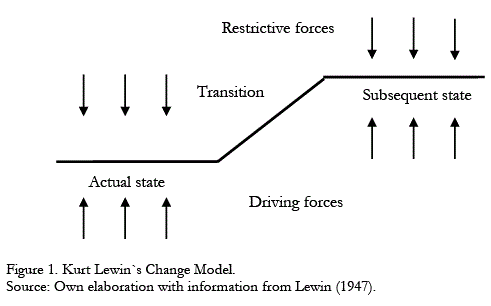
As can be seen in the previous figure, the first stage called the unfreezing of the current state: It allows analyzing the restrictive and driving forces of the current situation that is being modified in search of the desired situation. The second stage modification or transition: It is the process of changing the situation in which the corresponding interventions are made, transformations in the current processes to look for new behaviors at the individual and organizational level. The last and third stage is the recongellation or the subsequent state: They are established when the desired change is reached and the benefits of the change are achieved, which seeks the stability resulting from the modifications made (Lewin, 1947).
In consideration of the first stage of Lewin's change model, in Table 1 shown below, the driving and restrictive forces of the proposed problem are presented.
4. THEORETICAL-CONCEPTUAL AND EMPIRICAL REVIEW
It is a mistake to think that the management of a system that operates under a family business is the sole responsibility of the family members, contrary to this, the administration and direction of the company, is part of the assets of the family, is to say, is the very property of each of its elements. In the world close to 50% and 80% of companies are family. In Mexico this percentage is higher and oscillates in 90% of the total of the companies in the country (La Salle, 2014). And thanks to their centralization in decision-making, they do not require an operational and planning structure (Durán and San Martín, 2013).
The good perception of the commitment and responsibility of the shareholders and of all those involved in the succession process is extremely important, since it is the result of success in the generational change of top management (Sharma and Irving, 2005). Added to this, Oviedo (2004) considers perception as the fundamental process of mental activity, and assumes that other psychological activities, such as learning, memory, thinking, among others, depend on the proper functioning of the process of perceptual organization.
On the other hand, values play a fundamental role in the socialization of successors. These values are implemented by the founders and originate in two stages of socialization: The first stage focuses on family socialization and the second on business. Where, the fulfillment of two different objectives that depend on the socialization approach are identified; and they are based on the Foundational Homosocial Reproduction Model and the New Leaders Development Model (García-Álvarez, López-Sintas, Saldaña, 2002).
Regarding the participation, belonging and commitment of the leaders when making a generational change, the Theory of the Agency (developed by Jensen and Meckling 1976, cited by Vilaseca, 2002) suggests that those with greater participation in the actions, are more involved with the problems and their solution. In addition to the above, Breton-Miller, Miller and Lester (2010) argue that in family businesses the administration is executed with a futuristic vision towards their companies, performing actions that increase the capital of all the members of the company. However, based on the Theory of the Agency, this is limited by the particular interest of the actors with greater participation or those who are in the top management.
From another perspective Vilaseca (2002) examines the levels of identity, belonging and commitment as elements that influence the conflict of interests and objectives between shareholders who do not work in the family business and those who make up the senior management team of the same. In this sense, the result is that the degree of commitment to the company is negatively correlated with the number of family members in management positions and, on the contrary, the commitment to raise the level of growth of non-managerial members. It generates a positive attitude. Attitude towards the company. It also notes that the results of the mechanisms and processes implemented depend on the attention that the company provides to the three subsystems of the organization: property, family and company.
In a study conducted on five successful family businesses in their first succession, it is observed that there are differences between the phases of the succession process and that only until the moment when the new leader is in office, is it true that the predecessors they face an important transition, where, in addition, the role they will have within the company is uncertain (Cadieux, 2007). However, top management drives the transition process, by supporting the renewal through actions that allow to create a commitment to the new leadership and its strategy (Sievinen, Ikäheimonen, Pihkala, 2019).
The process of succession in a family business is extremely important, since it can depend on the company's results until its possible disappearance if a plan with well-established commitments is not prepared on time. This succession plan must be decided on the configuration of a new property, since who controls the property exercises the power (Belausteguigoitia, 2010). For many family shareholders, the surname is a source of pride and its preservation becomes amotivator thatgenerates not onlyasense of belonging but a high level of commitment to the effort to preserve it. This feeling can be the trigger for greater dedication and commitment in the company, which, in some cases, extends to other members of the family (Vallejo, 2007).
Succession is not a simple matter and, therefore, its planning is not either. The high mortality rates that characterize family businesses in generational leaps are perhaps the best proof (Araya, 2011). Likewise, the expectations that precede a succession process with respect to the stability and welfare of the outgoing owners are indirectly linked to the performance of the company itself (Collins, Worthington, Schoen, 2016). Derived from the above, generational succession in senior management must generate confidence in managerial positions, since they are the ones that lead the operation of the company and ensure that the service provided is of quality to always satisfy customers.
Due to the importance of family businesses in different areas (economic, business, professional, political and university), their disappearance is a concern (Friedman and Friedman, 1994). It is estimated that only one in three family businesses is successful in the next generation (Belausteguigoitia, 2004). On the other hand, a study carried out in a period from the year 2000 to the year 2014 on articles referring to family businesses, shows that the predominant approach of the studies of 75 articles is positivist and it is foreseen that this trend will continue (Leppäaho, Plakoyiannaki, Dimitrates, 2015).
Derived from the above, the process of succession acquires great importance, since, if it is badly planned or not planned, the capacities that differentiate them from other types of organizations and that grant them an important competitive potential, can be threatened (Vancil, 1987, Handler, 1994). In addition, consider that family successors are obliged to comply with fundamental aspects to ensure their success, according to their predecessors. These can mainly focus on three; The first aspect is the physical skills, necessary but insufficient by themselves. Soft skills and hard skills (Schlepporst, Moog, 2014).
The importance of family businesses in Mexico is insufficient and the perception of these is an undervaluation on the part of the organizational sectors. They are considered unprofessional, since some tend to hire family members only because of the relationship, but not for the quality of their work. They do not usually enjoy a good reputation, because it is more common to hear stories of failure than of success (Nelton, 1993). The study of family businesses has been covered from the beginning with difficulties that do not finish solving. One of them refers to the point of departure of the discipline: its definition of the object of study. Aronoff and Ward (1995) point out that it is possible to consider if this type of organization is simply a relic of the past destined to disappear or if it constitutes a business model that must be imitated to adapt to the future economic environment.
In this order of ideas, it can be taken into account that out of every 100 family businesses only 34 manage to overcome the first generational change; Of those 34, only 30% manage to reach the third generation. However, 63% of family businesses want the continuity of their company, although two thirds of family businesses do not feel prepared for the succession and halfof their managers believe that they should never retire (PricewaterhouseCoopers and IEF, 2007). Therefore, considering succession as a process seems to better define this fact, which characterizes family businesses anywhere in the world (Handler, 1989, Leach, 1993, Gallo, 1995, Ussman, 2004, Araya, 2011).
It is thus, as it is inferred that for success in the process of succession of family businesses, it is essential to meet the requirements and needs of family members in individual terms. Where, in addition, all the phenomena that are present in this process must be considered. Consider these phenomena related to personality that alter the company's environment (Marler, Botero, De Massis, 2017). On the other hand, the development and needs of non-family members will be strictly assumed in accordance with the requirements of the company. The above is the bestway to make this process work (García-Tenorio and Pérez, 2009).
5. HYPOTHESIS
The objective of the present investigation is to determine the perception of the sense of belonging and commitment of the employees of the Consortium object of study, in a process of generational succession of the leader of the same. This leads us to the following hypotheses:
Ho: There is no change in the perception of the commitment and the sense of belonging of the employees during a process of generational change in the leader of the Consortium.
Ha: There is a change in the perception of the commitment and the sense of belonging of the employees during a process of generational change in the leader of the Consortium.
And specifically:
Hi: Does the success of a generational succession process in the leader of a group of family businesses depend on the commitment and sense of belonging of the employees of the same?
6. METHOD OF ORGANIZATIONAL DEVELOPMENT
El análisis de las prácticas de Responsabilidad Social Empresarial-Ambiental The design of this research seeks to describe the perception of the shareholders, the main executives, the general staff and the middle managers of a family consortium of companies engaged in foreign trade, during a generational change in relation to the commitment to the organization and the sense of belonging. Since it focuses on perception (the way in which subjects perceive a situation), it is qualitative research. The quantitative method is used for the statistical analysis of the responses of the applied surveys, to identify if there is any change in the perception of the sense of belonging and the level of commitment of shareholders, senior executives and middle management personnel to have a generational change.
In top management, the information obtained serves to generate enough information to be able to conclude whether the perception changes positively or negatively in said members. The method that will be used for the collection of information will be descriptive through surveys, as well as observation during the transition period. Due to its origin, it is mixed, since, to study the impact of generational change on top management, field and documentary research is required, based on documents such as consulting books, articles or essays in magazines, newspapers and documents with academic validity, which will be complemented by field research that will be conducted based on surveys and observations.
For its usefulness, it is applied since it seeks the use of the knowledge that is acquired in order that the result of the research can serve to improve the process of generational change or, in its case, demonstrate that the process that has been applied is cash. For its objective, it is descriptive because it is a definition of the current situation of the consortium under study and the moment that is currently happening during the generational change; deepen the reaction of shareholders and senior managers during this change (both in the sense of belonging and in the level of commitment). For the management of information is an analytical research, since it seeks to analyze what is happening at a particular time during a situation of generational change and changes that may affect the company.
A. Diagnostic instrument
The questionnaire used developed by Herrera (2012) and adapted by Jurado (2014), consists of three parts: the first measures the commitment that the respondents have with the company, the second measures to what extent they identify with the company and the third part the motivation they receive in their daily activities. The instrument was an own elaboration using the modality of the Likert scale, also known as summative evaluation, where some help items were taken. In this type of scale, the level of agreement or disagreement is specified with a statement with the total scores to analyze the results according to an established range. The questions used in the interviews of the current president and the successor were of own evaluation, designed exclusively for the purposes of this work.
B. Alternative solution
If, as a result of the investigation, it is concluded that there is a change in the perception of employees at all levels in a high percentage during the process of succession, they would have to take different actions from the current ones, such as:
1) Activities to motivate staff explaining the benefits of the succession process.
2) Integration to the process of succession of all the personnel.
3) Work meetings
C. Development of the theme
The research technique used is field research, developed with the implementation of collection techniques and results analysis based on surveys applied to the main managers in charge of the main areas of the company and employees of the middle managers, through different interviews, the president and the successor and with the observation that were made at different times of the company. The foregoingwith the objective of describing the perception of the main stakeholders and leaders of the Consortium of the companies under investigation, with respect to the commitment to the organization and the sense of belonging as factors that influence the success of a period of succession in the presidency of the group.
In a first stage, semi-structured surveys were conducted with the majority shareholders who are the president and his successor, with the purpose of presenting the objectives of the investigation and obtaining their authorization to continue with the investigation. In the second stage, the surveys were applied to minority shareholders and management positions, to personnel in management positions and to employees in middle positions in the Consortium studied. Based on the answers provided, he was able to describe whether a generational change in senior management, changes in the perception of senior executives and other shareholders, if a lack of confidence or improvement in processes is perceived with this generational change in the leaders of the group.
In the third stage, the behavior of the participants in the study was analyzed at different times and circumstances, which helps to describe the impact of the generational change mentioned above. This research is based on the study methodology of Vilaseca (2002), who demonstrates, from a positivist perspective, the relationship between participation, the degree of commitment, identity and the sense of belonging perceived by the dashboards in companies family members, adapting it, to include senior managers who are not members of the group, but who have been in charge of the area for more than 10 years. All of the above, during a period of succession of the group's president, which is the highest position, occupied by the majority shareholder.
This study is of a descriptive type, which is elaborated based on the information that is collected from the surveys. The design is not transversal since the data is collected in a single moment in its natural context, through surveys applied to the shareholders and the rest of the executive body. With the purpose of describing the current perception of the principal directors (including the president and his substitute) during the generational change in senior management.
The questionnaires were administered directly to each of the group's main executives, as well as to the staff of the middle management, to the successor as head of the Innovation Department and to the president, and a personal interview was applied. Each individual received an email with the questionnaire. Separately, the behavior of each one of those involved was observed at different times during the development of the investigation. A simple statistical analysis was used to process the information. Initially, it allowed a descriptive and frequency analysis of the main variables. Subsequently, an analysis of variance was performed, where the statistically significant differences present in each of the variables were determined.
To carry out the study, it is necessary to follow a series of steps, which are presented below:
1) The contact with the subjects was done electronically to apply the instrument individually.
2) After the above, we proceeded to tabulate the data to generate the presentation of the results.
3) According to the data obtained in the tabulation, the results were obtained according to what is presented in the graphs through the basic statistical analysis.
4) On the basis of what was analyzed in the interpretation of the results, a discussion was reached, in comparison with what was gathered in the theoretical framework.
5) Through the discussed and analyzed conclusions of the research were made, and at the same time recommendations were generated as an alternative to resolve the findings.
6) Finally, an improvement proposal for employers was generated as an alternative for the solution.
The statistical methodology used was the measures of central tendency (mean, median and fashion) and percentages that supported the analysis of the results, all with the support of Excel. Results tables were used for the presentation of results. In this chapter, the results obtained through the questionnaires that were made to the main governing body of the consortium of this study, surveys applied to the president and future substitute, as well as their interpretation and observation of those involved at various times during the development, are shown. of group management, when a generational change is being implemented in senior management.
D. Population and sample
El primer análisis determinado con esta técnica se realizó con el clúster 1, Sources of consultation both documentary and field.
1) Places: internet portals, libraries and business archives.
2) Types of sources: books, research articles and thesis.
3) Quality of the sources: primary and secondary.
Delimitation of the universe.
1) Indication of inclusion characteristics: Mexican consortium of companies engaged in foreign trade, in the process of succession of senior management.
2) Geographical or spatial delimitation: the city of Veracruz.
3) Temporal delimitation: 2016, which is the year in which the succession process took place.
4) Exact number of members of the universe: 8 companies.
Selection of the sample.
Due to the nature of the study, it is not considered a sample, since it will be applied to the universe corresponding to 8 companies that make up the Consortium.
Documentary techniques
In the present investigation, the bibliographic records and the electronic worksheets will be used as documentary techniques.
Selection of field collection techniques.
1) Techniques used: Surveys, interviews and observation.
2) Justification of the selection: For the type of descriptive research, the surveys should be conducted with the personnel directly involved in the research and use as support the bibliographic sheets and worksheets of the books, research articles and theses with related topics.

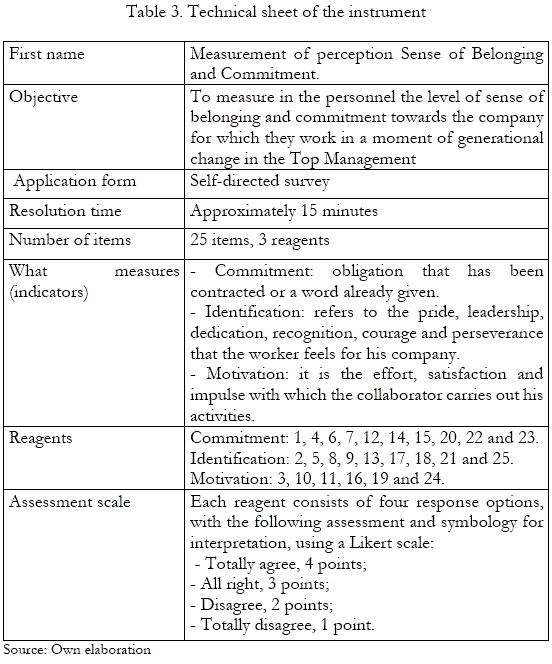
According to the interpretation obtained in the applied frequency scale, itwas classified in the following levels:
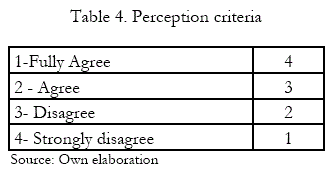
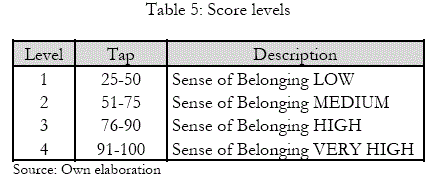

7. ANALYSIS OF RESULTS
A. Results of the Survey
Department in which the respondents work (including minority partners who perform managerial functions in some area of the Group).
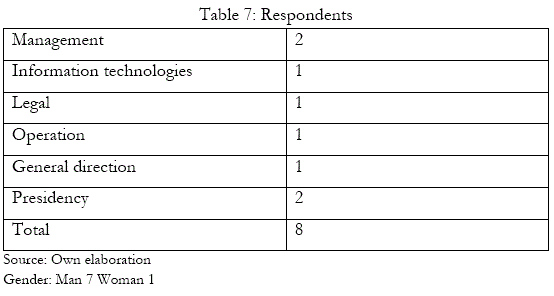
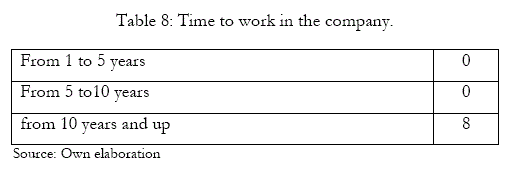
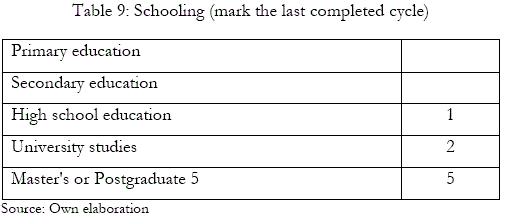
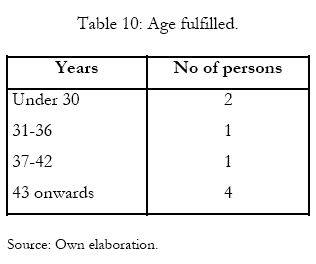
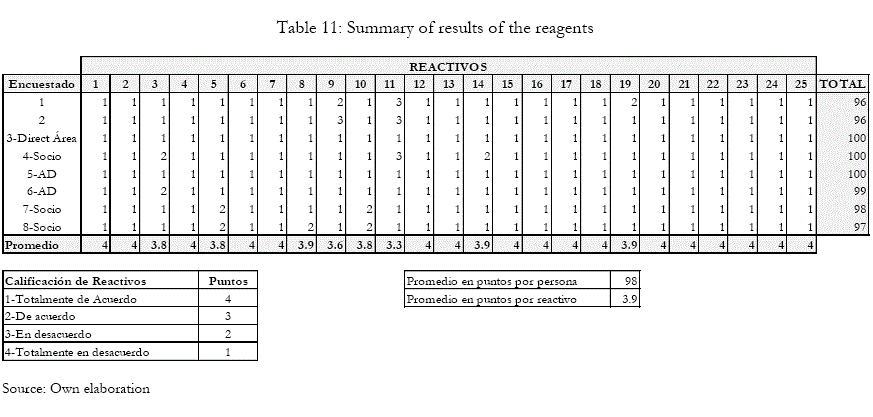
B. Interviews with the current president and the substitute
In order to identify the perception of the sense of belonging, the success of the succession process and the support received from the main managers and employees during the same, a separate survey was conducted to the current president and the person who is in training for replace it, who is your son. The surveys were conducted in the transition period of the succession of the position of Presidency of the Consortium of companies dedicated to foreign trade, the basis of this study, separately and in a neutral environment.
C. Descriptive analysis
It was divided the reagents of the survey applied to the main Managers and directors of the Group in three levels, commitment, identification and motivation in the following way:
a) Commitment: 1, 4, 6, 7, 12, 14, 15, 20, 22 and 23.
b) Identification: 2, 5, 8, 9, 13, 17, 18, 21 and 25.
c) Motivation: 3, 10, 11, 16, 19 and 24.
Based on the results obtained from the surveys, we can identify the following:
a) Commitment - The people surveyed as part of the sample, are highly committed to the company and the executives of the same and that has not changed during the generational process, achieving the highest score of the three levels with an average value of 3.99, being the highest 4.00
b) Identification. - People identify with the company inside and outside of it and feel proud to belong to the Group and consider the succession of the Group Presidency as their own change, achieving an average of 3.93 points, the highest value being 4.
c) Motivation. - Employees are motivated to do their work day by day, since the Group offers a good working environment, excellent facilities and benefits above what is offered in the market, a situation that has even improved in the succession process of the Presidency. Although the average was lower than the other two levels, it is still a high value, obtaining an average of 3.80 points out of a total of 4.
Comparing the results of the questionnaires with those of other studies, itwas perceived a high sense of commitment and belonging to the company. Staff turnover is low and that has improved during the process of succession of the Group Presidency, as working conditions improved. From a different survey applied to the president and the future successor, it is shown that although they have different ways of thinking, both are focused on the same succession plan, highlighting the following points:
a) They are 100% committed to the succession plan.
b) The succession project has been planned for many years and had external advice.
c) The Group's main directors have been working for it for many years, so they were informed at all times and have been part of this process.
d) The differences of opinion derived from the generation gap have achieved an important synergy by combining the best of the experience of the generation that is leaving the leadership, with the innovation of the "Y" generation, achieving better results in the Group.
e) It is estimated that the succession process will end in three years, time in which the internal and external successor training will end, considering as internal, the experience that should continue to obtain to be the president of such a large and important Group in Foreign Trade Nationally.
f) As a result of the surveys applied both to the President of the Group and to the successor, it is evident that both are fully committed to the process, have the support of the principal directors of the group, and although there are some differences of opinion due to the generation gap, they have known how to merge both experience and innovation, resulting in growth in the Group, at the time of the study.
g) The success of the succession process that takes so far, is because it has been planned for years, as the president's son was the only viable candidate to succeed him, so many projects were carried out thinking about this succession. They were advised by an external office, which included the main directors to feel part of the changes.
D. General data of the respondents
1) The current president is over 60 years old and the substitute is less than 30 years old. Both are male.
2) Only 10% of the respondents are female.
3) 100% of the respondents have more than 10 years of working in the companies of the group, so they feel part of it.
4) 25% is under 30 years old, considered "Y" generation, including the substitute.
5) 3 of the 8 managers or those in charge of the main areas are minority partners and are relatives of the president and his substitute and there are no more relatives working in the companies.
E. Results of observation
Although this research was recently started, working within the Consortium base of this study has allowed me to observe the changes that are taking place as the substitute has become involved in the group's questions.
During the boards of directors where all those involved in the current investigation are present, it has been observed that the substitute is having more and more participation and his ideas have been taken into account. These ideas have been accepted by the current president, although they are considered avant-garde (and at other times he had not accepted them). For example, an improvement in the schedule, grant English classes to staff, flexibility in dressing on Fridays, modifications that have generated a decrease in staff turnover and have been very well accepted. The nonverbal language in managerial meetings where everyone agrees, is acceptable and pleasing to show support in most of the proposals and decisions of the substitute.
The increasing incorporation of the substitute throughout the last months, the acceptance of his proposals and the nonverbal language observed in the meetings of the Council and others in which both the substitute and the other directors are present show that the latter, as well as the leader of the consortium, they have a favorable disposition to accept the substitute. This impression derived from the observation was reinforced with the information obtained in the applied surveys.
8. CONCLUSIONS
The success of the succession process depends on a series of circumstances that must exist and above all prepare with due time. In the case studied, a preparation was carried out that lasted several years, including establishing the requirements of the successor, the previous preparation of the same and the inclusion in the process of the main leaders of the Group, so that point, unlike other investigations where the response was not favorable, it was considered made the difference for the success of the development of the succession.
When studying the dimensions of the sense of belonging and commitment that shareholders and senior managers have in a moment of succession of the presidency of the base consortium of this study, itwas found that everyone is really committed and part of the company, and that feeling is not changes, although a succession is taking place in the highest position of the company, which is occupied by the majority shareholder. All are focused on the proper functioning of the companies that are part of the Consortium and are part of the successful succession process at the time of the investigation.
According to the results of the empirical observation of the Consortium, the same level of ownership and commitment can be seen in both senior executives and shareholders who feel part of the company and therefore are interested in the succession process being successful.
The three indicators used in the present investigation came out at an above-average level. These high levels of organizational commitment that commonly originate in the successful family business tradition, are related to the preservation of the surname, which is synonymous with pride for family shareholders, and in this case also for non-family managers, as they feel part of the company and therefore it is also pride that the family name, usually included in the name of companies, is preserved through the years.
This sense of pride and belonging can be the trigger for greater dedication and commitment in the company, extended to Altos direct with more than 10 years in the company (Vallej o, 2007). Unlike the results of other research, where the high sense of commitment and dedication in the company, depends only on the share percentage, in the Consortium that is studied in this document, the level of commitment is high when they have already a considerable antiquity in companies, in this example, more than 10 years, already feeling part of the company, even if they are not partners.
Succession is easier if the leader is predisposed to delegate, disengage, be generous, grant autonomy and not interfere, establish trusting relationships with his family and collaborators (Araya 2011). In the study carried out, it is noted that in the part of the process where he is, the leader has met these requirements, preparing for this moment for several years and with the advice of an office dedicated to these issues, which increases the success rate in this process.
Because of the importance of the topic, it is recommended to involve all the staff in the expected change, explaining with clear goals and objectives what is expected of them and what can happen if the succession of the group of companies is not successful. In addition to the above and as a last point, an agent of change will achieve better results by being out of the company and not involved in any process. Itwill give the necessary courses to reinforce the sense of belonging of the employees and therefore the motivation through incentives, "T" workshops, etc.
For all the aforementioned, and carrying out the recommended reinforcement, it is expected that the process of generational succession in the group leader will be carried out successfully.
REFERENCES
Ahmed, A. M.; Yang, J. B. &; Dale, B. G. (2003). "Self-assessment methodology. The route to business excellence". The Quality Management Journal, 10(1), 43-57. [ Links ]
Araya, A. (2011). La sucesión de empresas familiares costarricenses: factores de éxito y fracaso. Tesis Doctoral, Universidad de Valencia, España. [ Links ]
Aronoff, C.E. y Ward, J.L. (1995). Family-owned businesses: A thing ofthepast or a modelfor thefuture? Family Business Review, 8: 121- 130. [ Links ]
Belausteguigoitia, I. (2010). Empresas familiares, su dinámica, equilibrio y consolidación. México, D.F.: Mc Graw-Hill. [ Links ]
Breton-Miller, I.L., Miller, D., Lester, R. H. (2010). Stewardship or Agency? A Social Embeddedness Reconciliation of Conduct and Performance in Public Family Businesses. Organization Science, 22 (3), 541-815. doi: https://doi.org/10.1287/orsc.1100.0541 [ Links ]
Cabrera, K. (1998). Factores determinantes del éxito y fracaso del proceso de sucesión en la empresa familiar (Tesis Doctoral). Recuperado de la base de datos de la Universidad de las Palmas de Gran Canaria. España 1998. [ Links ]
Cadieux, L. (2007). Succession in Small and Medium-Sized Family Businesses: Toward a Typology of Predecessor Roles During and After Instatement of the Successor. Family Business Review.20 (2), 95-109. doi: https://doi.org/10.1111/j.1741-6248.2007.00089.x. [ Links ]
Collins, J., Worthington, W.J., Schoen, J. (2016). Family Business CEO Succession: Examining Personal Retirement Expectations. Journal of Small Business Strategy. 26 (2), 51-70. [ Links ]
Chittoor, R. y Das, R. (2007). Professionalization of management and succession performance a vital linkage. Family Business Review, 20(l), 65-79.
Chrisman, J., Chua, J. y Sharma, P. (1998). Important attributes of successors in family businesses: an exploratory study. Family Business Review, 11(1), 19-34. [ Links ]
Durán, J.A., San Martìn J.M. (2013). Estudio comparativo de la empresa familiar en México en el contexto mundial. Revista de estudios en Contaduría, Administración e Informatica, 2 (5), 21-54. [ Links ]
Friedman, M. y Friedman, S. (1994). How to Run a Family Business. Cincinnati, Ohio: Beterway Books. [ Links ]
Gallo, M. (1995). Empresa familiar: Textosy casos. Barcelona: Editorial Praxis. [ Links ]
García-Álvarez, E., López-Sintas,J., Saldaña, P. (2002). Socialization Patterns of Successors in First-to Second-Generation Family Businesses. Family Business Review, 15 (3), 189-203. doi: https://doi.org/10.1111/j.1741-6248.2002.00189.x. [ Links ]
García-Tenorio, J. y Pérez, M. (2009). Elrelevogeneracionaly la estrategia de recursos humanos en la empresa familiar. Recuperado de la base de datos de la Universidad Complutense de Madrid. España 2009. [ Links ]
Gómez-Betancourt G., Betancourt, J.B., Zapata, N. (2012). Empresas familiares multigeneracionales, 8 (12), 38-49. [ Links ]
Handler, W. (1989). Managing the family firm succession process: The next-generationfamilymember's experience. UMI Dissertation Services. [ Links ]
Handler, W. (1994). Succession in family business: A review of the research. FamilyBusiness Review, 7:133-157. [ Links ]
Herrera, G. (2012). Relación entre sentido de pertenencia y estabilidad laboral. Tesis inédita. Universidad Rafael Landivar. Guatemala. [ Links ]
Jurado, A (2014). Los niveles de sentido de pertenencia en un grupo de profesionales bajo contratación laboral simulada en distintas organizaciones guatemaltecas. Universidad Rafael Landivar. Guatemala. [ Links ]
Leach, P. (1993). La empresa familiar. Barcelona: Ediciones Granica. [ Links ]
Leppäaho, T., Plakoyiannaki, E., Dimitratos, P. (2015). The Case Study in Family Business: An Analysis of Current Research Practices and Recommendations. Family Business Review. 29 (2), 159-173. doi: https://doi.org/10.1177/0894486515614157. [ Links ]
Lewin, K. (1947). Frontiers in Group Dynamics: Concept, method, andreality in social science; social equilibria and social change. Retrieved from Sage Journals: http://journals.sagepub.com/doi/abs/10.1177/001872674700100103. [ Links ]
Longenecker, J., Moore, C. y Petty, W. (2001). Administración de pequeñas empresas. México: Thomson Learning. [ Links ]
Marler, L.E., Botero, I.C., De Massis, A.V. (2017). Succession-related role transitions in family firms:the impact of proactive personality. Journal of Managerial Issues, 29 (1), 57-81. [ Links ]
Nelton, S. (1993). Why don't we dish the dirt. Family business Review.. E.U.A.: pp. 81, 61. [ Links ]
Nordqvist, M., Wennberg, K., Bau, M., Hellerstedt, K. (2013). An entrepreneurial process perspective on succession in family firms. Small Business Economics. 40 (4), 1087-1122. doi: https://doi.org/10.1007/s11187-012-9466-4. [ Links ]
Oviedo, G. (2004). La definición del concepto de percepción en psicología con base en la Teoría Gestalt. Revista de Estudios Sociales. No 18. Bogotá, Colombia. Mayo/Agosto 2004. [ Links ]
Poza, E. (2010). Family Business., 3e. Recuperado de: https://BOOKS:GOOGLE:HN7books?id=IRHXQWAACAAJ&source=gbs navlinks s. [ Links ]
PricewaterhouseCoopers, Instituto de la Empresa Familiar y Red de Cátedras del IEF (2007): "Políticas de Capital humano en la Empresa Familiar", Documento 142 del IEF. [ Links ]
Quijano, R., Magaña, D., Perez, C. (2011). Pertenencia y compromiso: factores relevantes en la transición generacional de empresas familiares. Caso constructoras Campeche, México. Estudios Gerenciales, 27 (121), 99-114. Recuperado de https://www.icesi.edu.co/revistas/index.php/estudios_gerenciales/article/view/1119. [ Links ]
Schlepporst, S., Moog, P. (2014). Left in the dark: Family successors' requirement profiles in the family business succession process. Journalof Family Business Strategy. 5 (4), 358-371. doi:https://doi.org/10.1016/j.jfbs.2014.08.004. [ Links ]
Sievinen, H. M., Ikäheimonen, T., Pihkala, T. (2019). Strategic renewal in a mature family-owned company A resource role of the owners. ScienceDirect. 52 (2), 155-282. doi: https://doi.org/10.1016/j.lrp.2019.01.00. [ Links ]
Sharma, P. e Irving, G. (2005). Four bases offamily business successor commitment: antecedents and consequences. Entrepreneurship Theory and Practice. Documento 29 (1), 2005, 13-33. [ Links ]
Ussman, A. (2004). Empresas Familiares. Lisboa: Editorial Silabo. [ Links ]
Vallejo, M. (2007). El compromiso de la empresa familiar bajo una óptica de liderazgo transformacional y aprendizaje organizacional. Investigaciones Europeas de Direccióny Economía de la Empresa, 13 (3), 217-234. [ Links ]
Vancil, R. (1987). Passing the batan: Managing theprocess of CEO succession. MA, Estados Unidos. Harvard Business School Press. [ Links ]
Vilaseca, A. (2002). The shareholder role in thefamily business: conflict ofinterests and objectives between nonemployed shareholders and top management team. Family Business Review, 15(4), 299-320. [ Links ]
Annex A

Annex B
Interview with the current President
1.- Do you consider that the change of leader in the Group of companies is taking place at the opportune moment?
Time is the perfect one. In addition to analyzing it, we have external consultants who are helping us during this process. My son has been in the company for some time now, which has allowed him to see how the companies he will have under his charge work, how to control, supervise and make them grow, together with the diversity they have in an area as complex as it is foreign trade. In addition to the above, is finishing training both within the company and outside of it through a postgraduate abroad, which will bring new ways of seeing things, work and be able to merge with what has so far been success in the company. This merger will allow a modernization and constant improvement of our processes, which will result in a better result in both profits and living conditions for employees and partners.
2.- Have you felt that the main executives of the company have doubts about the change of the leader of the Group?
No. The main executives of the company have been working with the Group for more than 10 years and everyone knew that this change would take place, since we are a family business with only one possible successor. Therefore, all have supported the process of succession from the beginning.
3.- The main leaders of the group, do they have confidence in the future leader of the Group and its preparation?
Yes. They trust both my son and my criteria and have seen the work that has been done, as well as the maturation process that led to the current president of this Group at the present time.
4.- Do you consider that the future leader is ready to take responsibility?
Within the process that is planned, it goes on time. The project is estimated so that in 3 more years, I will retire completely and my son will be in charge of the Group thatwe have formed, as president.
5.- Did you speak before doing the projects to replace the presidency with the main executives of your companies?
As I mentioned earlier, for the years that everyone has been working within the Group, everyone was always aware. Having trained personnel in the main areas has allowed to grow and have the place it has in the country today, as well as being freer from foreign trade companies and dedicating myself to other things.
6.- Have you found important differences in the way you manage the company between you and your successor?
Of course. First of all, we are two generations and two completely different ideologies. But the fusion between experience and youth thatwe are achieving has merged perfectly. We have modernized the processes, making them more efficient, making sure that employees are convinced that we are the best option to work and that is why they understand the needs of the company and of the clients, who in the end, are the ones we sell our service to.
7.- How long do you think it is still necessary for the process of replacing the Chair of the Group to be completed?
Three years according to our project.
8.- How did the main executives and the Group's workforce react when they learned that a change in the presidency was going to take place?
Being a subject they already knew about, when they commented they took it as something natural in the process of a family business.
9.- The generation gap between the current president and the substitute in training, has it meant a bigger problem because of the different ideologies?
No. On the contrary. A very important merger has been made with the main strengths of the two generations.
10.- How have you overcome these differences?
Taking the best of the two generations, making it a fortress.
11.- What expectations do you have regarding employee commitment after the succession of the Group president?
100% commitment, as has been the case so far.
12.- What do you expect to happen with the rotation of personnel when the succession of the president of the Group has occurred and during the process?
Let it decreas e.
Annex C
Substitute Interview
1.- Do you consider that the change of leader in the Group of companies is taking place at the opportune moment?
The moment was excellent. It has allowed me to spend a few years in the company, know how it works, what can continue to work and how to improve it. Many things have been modernized, and although it is not easy to change the way of thinking of those who have done it in a certain way for many years, in the end that vote of confidence has been given to me and the results are palpable. The union of experience of the previous generation with the innovation of the "Y" generation is resulting in a stronger company, with more involved personnel and with the certainty that they work for the best company.
2.- Have you felt that the main executives of the company have doubts about the change of the leader of the Group?
No. Everyone knew them for several years and it was something they already knew was going to happen. All have been supporting the process and although there have been differences in the ways of thinking about some issues, in the end they have complemented my ideas with their experience and helped carry out the changes.
3.- The main leaders of the group, do they have confidence in the future leader of the Group and its preparation?
Yes. All have shown confidence and have seen that the changes and ideas that I bring have generated added value to the company.
4.- Do you consider that the future leader is ready to take responsibility?
We are within the times that we established from the beginning, but I still will not take full responsibility. That is estimated for a maximum of 3 years, during which time I will study a postgraduate abroad with the possibility of opening a branch in the place where I am living and start to provide logistics and marketing services. This will allow us to have a presence abroad and when I return to take the full reins of the Group, leave the office running 100%.
5.- Did you speak before doing the projects to replace the presidency with the main executives of your companies?
Yes, this topic was always discussed with them as the pillars of the Group.
6.- Have you found important differences in the way you manage the company between you and your future predecessor?
Yes, but the existing processes have been adapted to my proposals, reaching a mid-point. This has allowed us to improve customer service and therefore the recruitment of new customers, without losing sight of the quality of life of employees.
7.- How long do you think it is still necessary for the process of replacing the Chair of the Group to be completed?
Three years.
8.- How did the main executives and the Group's workforce react when they learned that a change in the presidency was going to take place?
They reacted in a positive way. The beginning of the process coincided with the retirement of two of the people who had more years in the company, but that was also something that we already knew was going to happen over the years of the people, so they had the support until their departure, and of the people who continue in the company, 100% support has been obtained.
9.- The generation gap between the current president and the substitute in training, has it meant a bigger problem because of the different ideologies?
No. Changes have been made to modernize the processes and adapt them to the current world.
10.- How have you overcome these differences?
The experience of previous generations is taken as a basis, adapting it to the current management situation and forms.
11.- What expectations do you have regarding employee commitment after the succession of the Group president?
That the degree of commitment not only remains the same, but improves. I have won the trust and will continue to do with my actions.
12.- What do you expect to happen with the rotation of personnel when the succession of the president of the Group has occurred and during the process?
I hope that the rotation of personnel is minimal and only of the personnel that do not agree with the values and policies of the Group.













